Calibration of the k-ω SST Turbulence Model for Free Surface Flows on Mountain Slopes Using an Experiment
Abstract
1. Introduction
2. Relevance
- a turbulent water flow in an inclined experimental chute flow to calibrate the turbulence model. The experiments were conducted by the authors at the Research Institute of Mechanics of Lomonosov Moscow State University (MSU);
- an experiment carried out at the University of Iceland (UI) to verify the calibration results;
- a potential glacial lake outburst flow (GLOF) at the Maliy Azau glacier as an example of application of the model to natural geophysical mass flow.
3. Experiment for Turbulence Model Calibration
4. Mathematical Model
5. Software
- preprocessing utilities (mesh generation and convertation, setting specific initial and boundary conditions),
- big base of standard solvers, a lot of extended solvers,
- postprocessing utilities (calculation, visualisation, convertation)
- well documented,
- modular code,
- the possibility of implementing new models,
- wide distribution, many developers and users.
5.1. Numerical Method
- time derivatives : first order, bounded, implicit Euler scheme;
- water volume fraction flux : Gaussian finite volume integration with vanLeer interpolation;
- convection term : Gaussian finite volume integration with upwind interpolation;
- divergence of the stress tensor : Gaussian finite volume integration with upwind interpolation;
- turbulent kinetic energy flux : Gaussian finite volume integration with linear (central differencing) interpolation;
- dissipation flux of the specific turbulent kinetic energy : Gaussian finite volume integration with linear (central differencing) interpolation;
- gradient terms ∇: Gaussian integration with linear interpolation;
- Laplacian terms : Gaussian integration with linear interpolation with explicit non-orthogonal correction;
- Other terms not listed above are discretized using a central difference scheme.
5.2. Computational Mesh for Lomonosov MSU Experiment
- The chute bottom is a solid wall with the no-slip condition;
- computational domain sides: the zero gradient condition is set to exclude the influence of sides on the flow;
- computational domain upper border: a mixed condition with atmospheric pressure, no inflow through the border and outflow according to zero gradient condition;
- the inlet section: fixed values of water volume fraction and flow velocity profile;
- the outlet section: a zero gradient condition for all parameters.
5.3. Computational Mesh for University of Iceland Experiment
- the horizontal part of the chute bottom, the reservoir walls, protective structures, end section of the chute are solid walls with the no-slip condition;
- the inclined parts of the chute bottom: no-slip condition with turbulent rough wall condition with roughness height of 2 mm;
- computational domain sides: empty boundary condition to implement two-dimensional domain;
- computational domain upper border: a mixed condition with atmospheric pressure, no inflow through the border and outflow according to zero gradient condition;
6. Optimization Algorithm
- Training of the optimization algorithm based on a Reynolds–Averaged Navier–Stokes equations (RANS) calculations with the k- turbulence model with different constants values;
- Obtaining new values of the coefficients using the optimization algorithm;
- Simulation of flow dynamics using obtained turbulence model coefficients;
- Additional training of the algorithm using the obtained flow dynamics data.
Development of an Automatic Optimization Module MLTFoam Optimization
7. Calibration Results
8. Verification of Calibration Results Using the Experiment of the University of Iceland
9. Maliy Azau Glacial Lake Outburst Flood
10. Results and Conclusions
Author Contributions
Funding
Institutional Review Board Statement
Informed Consent Statement
Data Availability Statement
Acknowledgments
Conflicts of Interest
References
- Briukhanov, A.; Grigorian, S.; Miagkov, S.; Plam, M.; Shurova, I.; Eglit, M.; Yakimov, Y. On some new approaches to the dynamics of snow avalanches. Phys. Snow Ice 1966, 1, 1223–1241. [Google Scholar]
- Grigorian, S.S.; Eglit, M.E.; Iakimov, Y.L. A new formulation and solution of the problem of snow avalanche motion. Tr. Vycokogornogo Geofiz. Inst. 1967, 12, 104–113. [Google Scholar]
- Eglit, M. Theoretical approaches to the calculation of the motion of snow avalanches. Itogi Nauki 1968, 60–97. [Google Scholar]
- Bakhvalov, N.; Eglit, M. Study of the solutions of equations of motion of snow avalanches. Mater. Glyatsiologicheskikh Issled. (Data Glaciol. Stud.) 1970, 16, 7–14. [Google Scholar]
- Eglit, M. Some Mathematical Models of Snow Avalanches. Adv. Mech. Flow Granul. Mater. 1983, 2, 557–588. [Google Scholar]
- Eglit, M. Calculation of the parameters of avalanches in the runout zone. Mater. Glyatsiologicheskikh Issled. (Data Glaciol. Stud.) 1982, 53, 35–39. [Google Scholar]
- Savage, S.B.; Hutter, K. The motion of a finite mass of granular material down a rough incline. J. Fluid Mech. 1989, 199, 177–215. [Google Scholar] [CrossRef]
- Kulikovskii, A.; Eglit, M. Two-dimensional problem of the motion of a snow avalanche along a slope with smoothly changing properties. J. Appl. Math. Mech. 1973, 37, 792–803. [Google Scholar] [CrossRef]
- Eglit, M. Unsteady Motions in Channels and on Slopes; MSU Press: Moscow, Russia, 1986. [Google Scholar]
- Mironova, E. Mathematical Modelling of the Motion of Water Flows, Snow Avalanches, and Floods. Ph.D. Thesis, Lomonosov Moscow State University, Moscow, Russia, 1987. [Google Scholar]
- Volodicheva, N.; Mironova, E.; Oleinikov, A.; Eglit, M. The use of mathematical modelling to determine the boundaries of propagation of avalanches. Mater. Glyatsiologicheskikh Issled. (Data Glaciol. Stud.) 1986, 56, 78–81. [Google Scholar]
- Christen, M.; Kowalski, J.; Bartelt, P. RAMMS: Numerical simulation of dense snow avalanches in three-dimensional terrain. Cold Reg. Sci. Technol. 2010, 63, 1–14. [Google Scholar] [CrossRef]
- Bühler, Y.; Christen, M.; Kowalski, J.; Bartelt, P. Sensitivity of snow avalanche simulations to digital elevation model quality and resolution. Ann. Glaciol. 2011, 52, 72–80. [Google Scholar] [CrossRef]
- Christen, M.; Bartelt, P.; Kowalski, J.; Stoffel, L. Calculation of dense snow avalanches in three-dimensional terrain with the numerical simulation program RAMMS. In Proceedings of the Whistler 2008 International Snow Science Workshop, Whistler, BC, Canada, 21–27 September 2008. [Google Scholar]
- Fischer, J.T.; Kowalski, J.; Pudasaini, S.; Miller, S. Dynamic Avalanche Modeling in Natural Terrain. In Proceedings of the International Snow Science Workshop, Davos, Switzerland, 27 September–2 October 2009. [Google Scholar]
- Pitman, E.B.; Nichita, C.C.; Patra, A.; Bauer, A.; Sheridan, M.; Bursik, M. Computing granular avalanches and landslides. Phys. Fluids 2003, 15, 3638–3646. [Google Scholar] [CrossRef]
- Patra, A.; Bauer, A.; Nichita, C.; Pitman, E.; Sheridan, M.; Bursik, M.; Rupp, B.; Webber, A.; Stinton, A.; Namikawa, L.; et al. Parallel adaptive numerical simulation of dry avalanches over natural terrain. J. Volcanol. Geotherm. Res. 2005, 139, 1–21. [Google Scholar] [CrossRef]
- Mousavi Tayebi, S.A.; Moussavi Tayyebi, S.; Pastor, M. Depth-Integrated Two-Phase Modeling of Two Real Cases: A Comparison between r.avaflow and GeoFlow-SPH Codes. Appl. Sci. 2021, 11, 5751. [Google Scholar] [CrossRef]
- Naaim, M.; Gurer, I. Two-phase numerical model of powder avalanche: Theory and application. Nat. Hazards 1998, 117, 129–145. [Google Scholar] [CrossRef]
- Sampl, P.; Zwinger, T. Avalanche simulation with SAMOS. Ann. Glaciol. 2004, 38, 393–398. [Google Scholar] [CrossRef]
- Hermann, F.; Issler, D.; Keller, S. Towards a numerical model of powder snow avalanches. In Computational Fluid Dynamics’ 94; Wiley: Chichester, NY, USA, 1994; pp. 948–955. [Google Scholar]
- Yamaguchi, Y.; Takase, S.; Moriguchi, S.; Terada, K.; Oda, K.; Kamiishi, I. Three-dimensional nonstructural finite element analysis of snow avalanche using non-Newtonian fluid model. Trans. Jpn. Soc. Comput. Eng. Sci. 2017, 2017, 20170011. [Google Scholar] [CrossRef]
- Oda, K.; Moriguchi, S.; Kamiishi, I.; Yashima, A.; Sawada, K.; Sato, A. Simulation of a snow avalanche model test using computational fluid dynamics. Ann. Glaciol. 2011, 52, 57–64. [Google Scholar] [CrossRef]
- Romanova, D.I. 3D avalanche flow modeling using OpenFOAM. Proc. ISP RAS 2017, 29, 85–100. [Google Scholar] [CrossRef][Green Version]
- Romanova, D. Comparison of Single-Velocity and Multi-Velocity Multiphase Models for Slope Flow Simulations. In Proceedings of the 2020 Ivannikov Ispras Open Conference (ISPRAS), Moscow, Russia, 10–11 December 2020; pp. 170–174. [Google Scholar] [CrossRef]
- Scheiwiller, T. Dynamics of Powder-Snow Avalanches. Ph.D. Thesis, ETH Zurich, Zürich, Switzerland, 1986. [Google Scholar] [CrossRef]
- Brandstatter, W.; Hagen, F.; Sampl, P.; Schaffhauser, H. Dreidimensionalle Simulation von Staublawinen unter Berucksichtigung realer Gelandeformen. Z. Der-Wildbach- Lawinebnverbauung Osterreichs 1992, 120, 107–137. [Google Scholar]
- Sampl, P. Current status of the AVL Avalanche Simulation Model—Numerical simulation of dry snow avalanches. In Proceedings of the “Pierre Beghin” International Workshop On Rapid Gravitational Mass Movements, Grenoble, France, 6–10 December 1993; Volume 1, pp. 269–296. [Google Scholar]
- Menter, F. Zonal Two Equation k-w Turbulence Models For Aerodynamic Flows. In Proceedings of the 23rd Fluid Dynamics, Plasmadynamics, and Lasers Conference, Nashville, TN, USA, 6–8 July 1992. [Google Scholar] [CrossRef]
- Menter, F.R. Two-equation eddy-viscosity turbulence models for engineering applications. AIAA J. 1994, 32, 1598–1605. [Google Scholar] [CrossRef]
- Menter, F.; Kuntz, M.; Langtry, R. Ten years of industrial experience with the SST turbulence model. Heat Mass Transf. 2003, 4, 1–8. [Google Scholar]
- Kalitzin, G.; Medic, G.; Xia, G. Improvements to SST turbulence model for free shear layers, turbulent separation and stagnation point anomaly. In Proceedings of the 54th AIAA Aerospace Sciences Meeting, San Diego, CA, USA, 4–8 January 2016; p. 1601. [Google Scholar]
- Rocha, P.C.; Rocha, H.B.; Carneiro, F.M.; da Silva, M.V.; de Andrade, C.F. A case study on the calibration of the k-ω SST (shear stress transport) turbulence model for small scale wind turbines designed with cambered and symmetrical airfoils. Energy 2016, 97, 144–150. [Google Scholar] [CrossRef]
- Rocha, P.; Rocha, H.; Carneiro, F.; Silva, M.; Bueno, A. K-ω SST (shear stress transport) turbulence model calibration: A case study on a small scale horizontal axis wind turbine. Energy 2013, 65, 412–418. [Google Scholar] [CrossRef]
- Launder, B.; Spalding, D. The numerical computation of turbulent flows. Comput. Methods Appl. Mech. Eng. 1974, 103, 456–460. [Google Scholar] [CrossRef]
- Tahry, S.H.E. k-epsilon equation for compressible reciprocating engine flows. J. Energy 1983, 7, 345–353. [Google Scholar] [CrossRef]
- Launder, B.; Morse, A.; Rodi, W.; Spaldiug, D. Spaldiug, The prediction of free shear flows—A comparison of the performance of six turbulence models. In Proceedings of the NASA Conference on Free Shear Flows, Hampton, VA, USA, 20–21 July 1972. [Google Scholar]
- Agustsdottir, K.H. The Design of Slushflow Barriers: Laboratory Experiments. Ph.D. Thesis, University of Iceland, Reykjavik, Iceland, 2019. [Google Scholar]
- Jones, R.A. The Design of Slushflow Barriers: CFD Simulations. Ph.D. Thesis, University of Iceland, Reykjavik, Iceland, 2019. [Google Scholar]
- Romanova, D. Architecture of Open Source Program for Numerical Modeling of Flows on Mountain Slopes. Proc. Inst. Syst. Program. Ras (Proc. ISP RAS) 2020, 32, 183–200. [Google Scholar] [CrossRef]
- Ferziger, J.; Peric, M. Computational Methods for Fluid Dynamics; Springer: Berlin/Heidelberg, Germany, 2002; Volume 3. [Google Scholar] [CrossRef]
- Berberovic, E.; van Hinsberg, N.P.; Jakirlic, S.; Roisman, I.V.; Tropea, C. Drop impact onto a liquid layer of finite thickness: Dynamics of the cavity evolution. Phys. Rev. E 2009, 79, 036306. [Google Scholar] [CrossRef] [PubMed]
- Rusche, H. Computational Fluid Dynamics of Dispersed Two-Phase Flows at High Phase Fractions. Ph.D. Thesis, University of London, London, UK, 2002. [Google Scholar]
- Hirt, C.; Nichols, B. Volume of fluid (VOF) method for the dynamics of free boundaries. J. Comput. Phys. 1981, 39, 201–225. [Google Scholar] [CrossRef]
- Ubbink, O. Numerical Prediction of Two Fluid Systems with Sharp Interfaces. Ph.D. Thesis, Department of Mechanical Engineering, Imperial College of Science, Technology & Medicine, London, UK, 1997. [Google Scholar]
- Holzmann, T. Mathematics, Numerics, Derivations and OpenFOAM®; Holzmann CFD: Loeben, Germany, 2019. [Google Scholar]
- Yin, R. Comparison of four algorithms for solving pressure-velocity linked equations in simulating atrium fire. Int. J. Archit. Sci. 2003, 4, 24–35. [Google Scholar]
- Guillas, S.; Glover, N.; Malki-Epshtein, L. Bayesian calibration of the constants of the k-ε turbulence model for a CFD model of street canyon flow. Comput. Methods Appl. Mech. Eng. 2014, 279, 536–553. [Google Scholar] [CrossRef]
- Ling, J.; Kurzawski, A.; Templeton, J. Reynolds averaged turbulence modelling using deep neural networks with embedded invariance. J. Fluid Mech. 2016, 807, 155–166. [Google Scholar] [CrossRef]
- Dokukin, M.; Khatkutov, A. Lakes near the glacier Maliy Azau on the Elbrus (Central Caucasus): Dynamics and outbursts. Ice Snow 2016, 56, 472–479. [Google Scholar] [CrossRef]

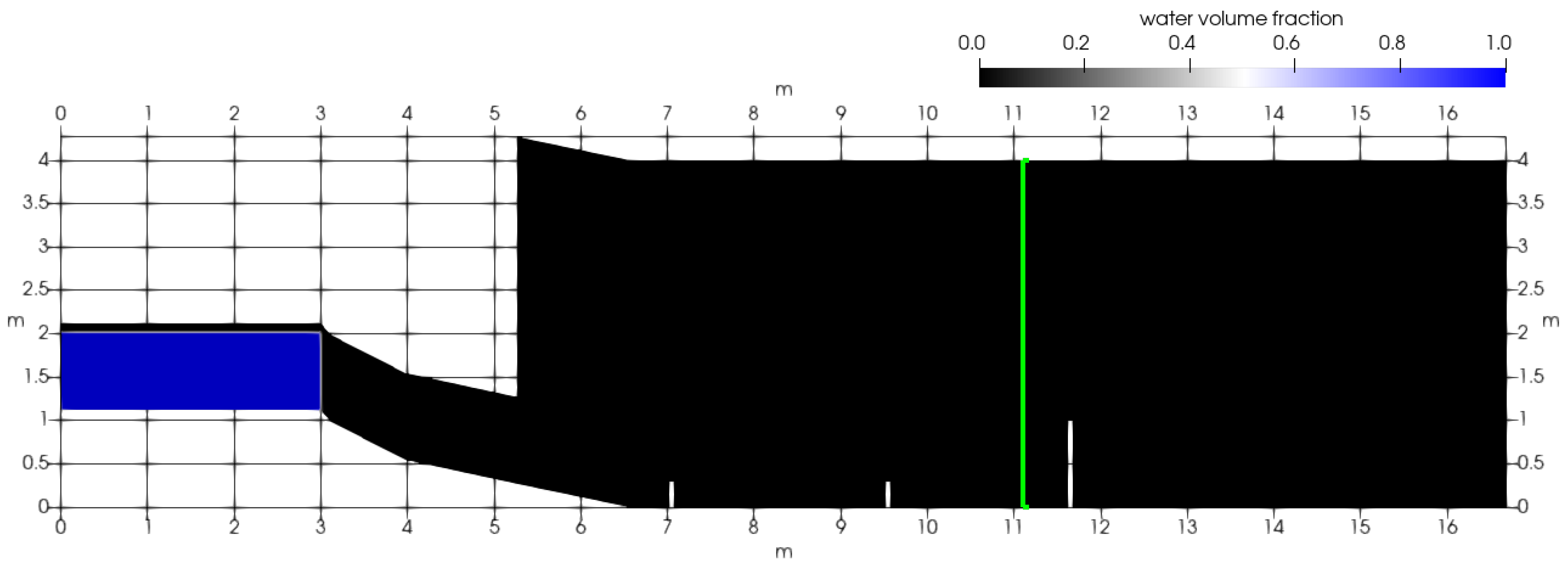

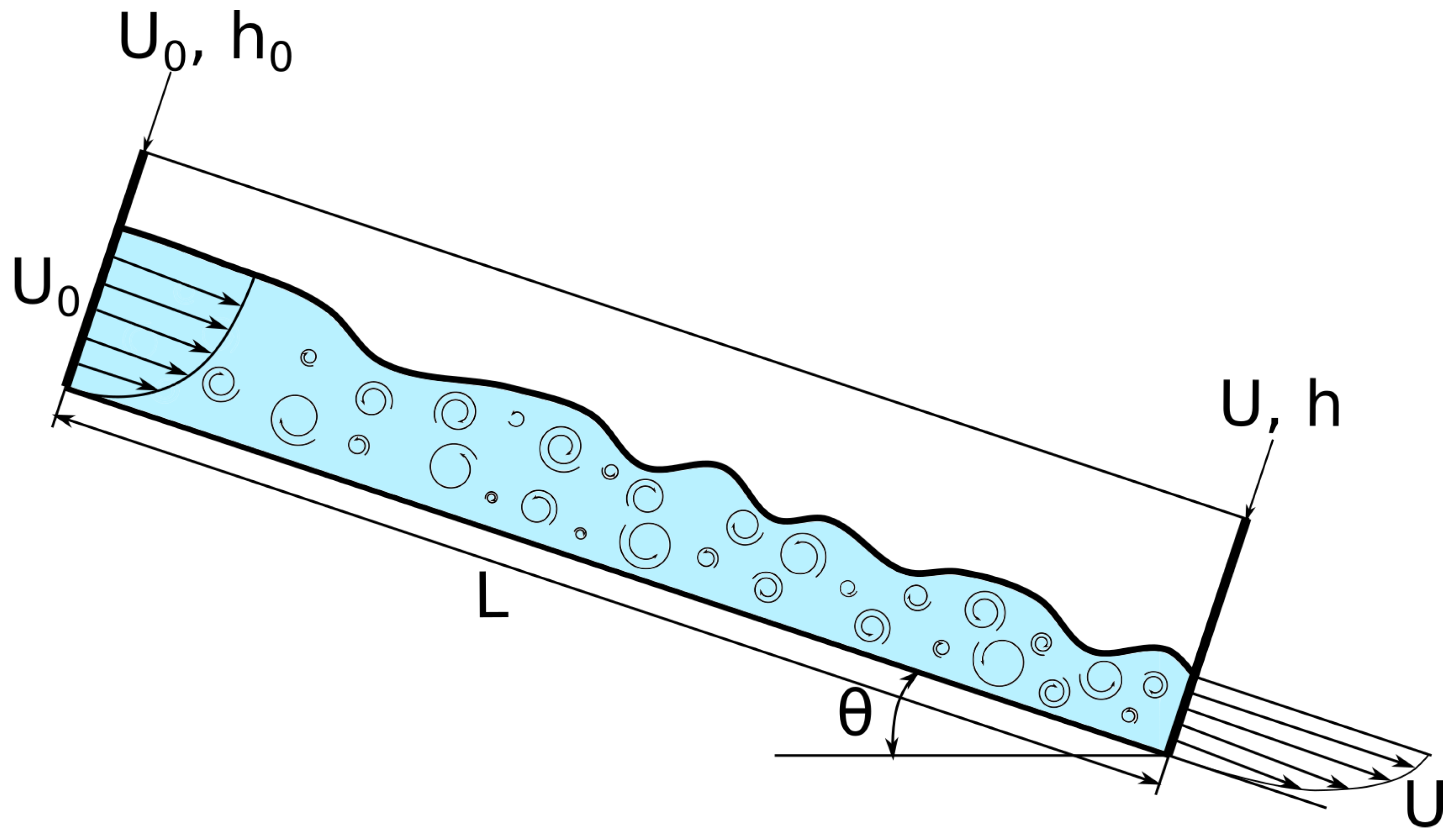
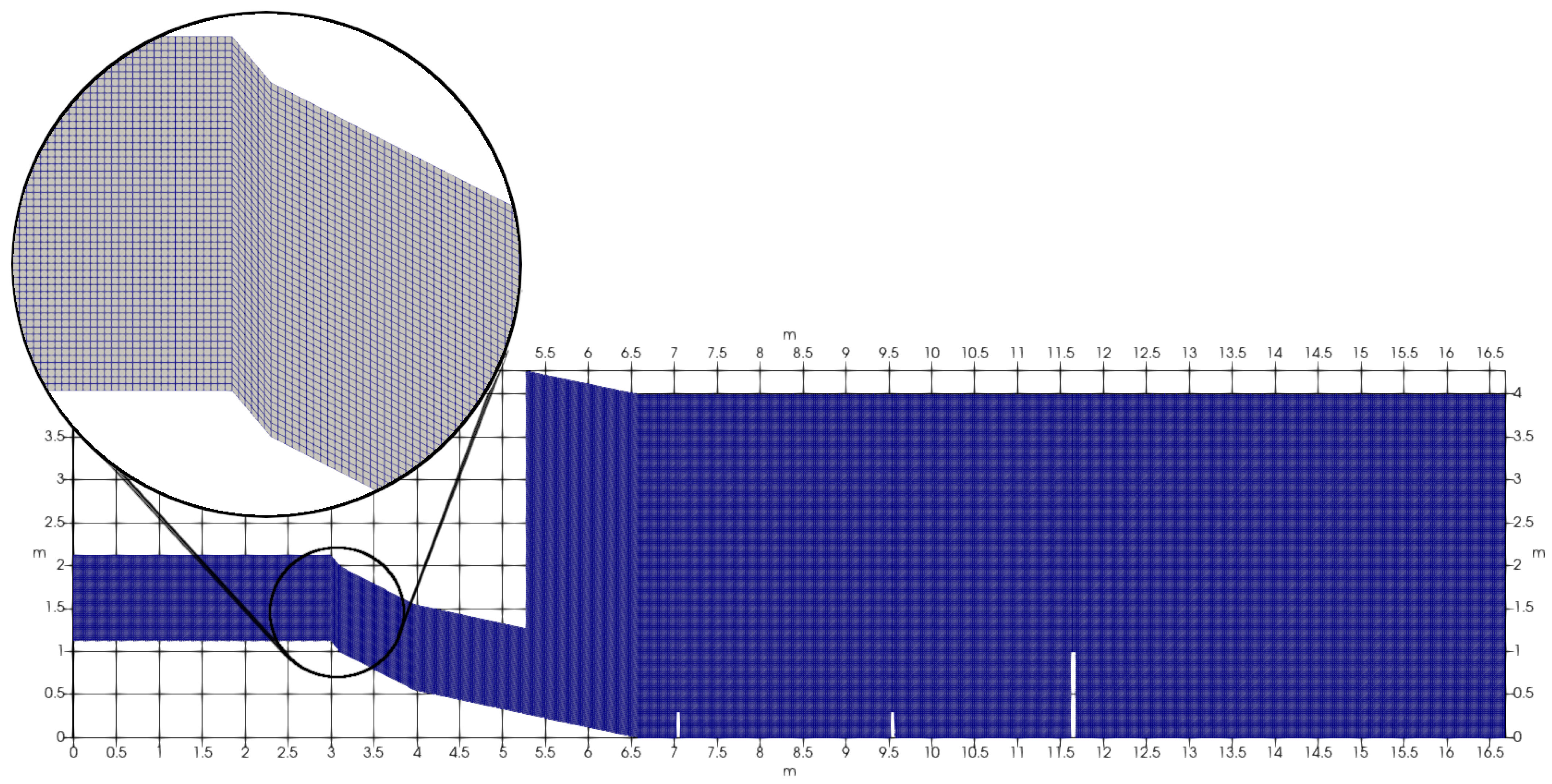


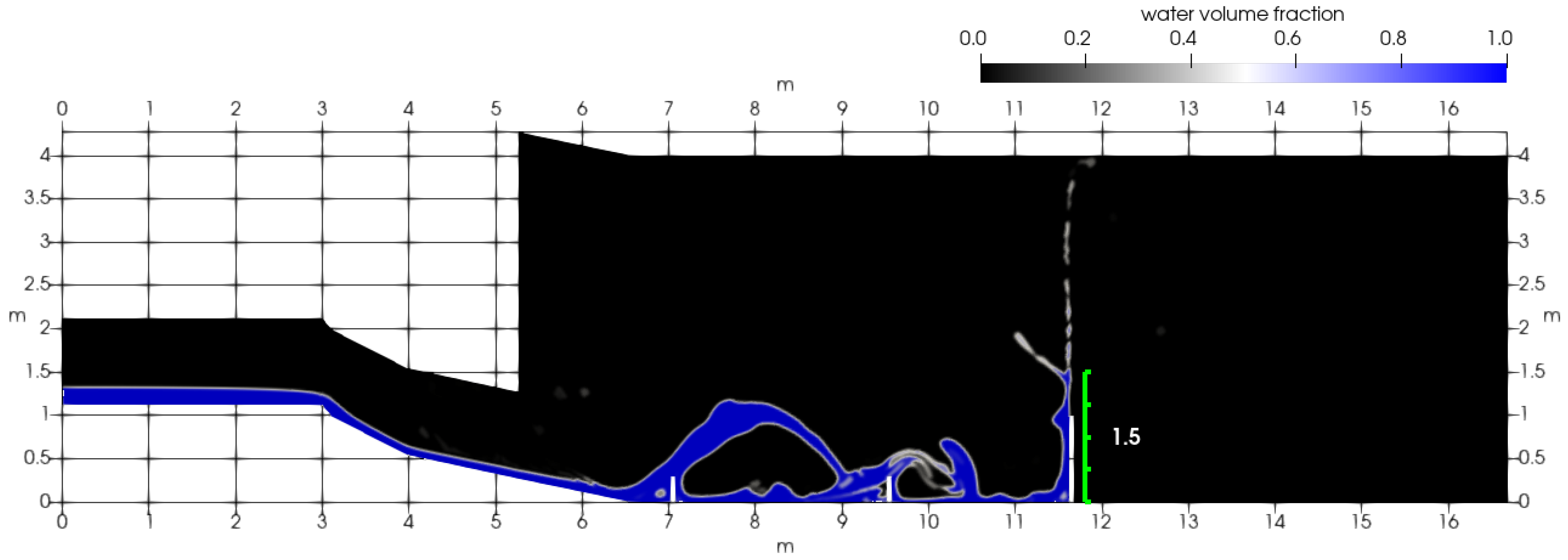
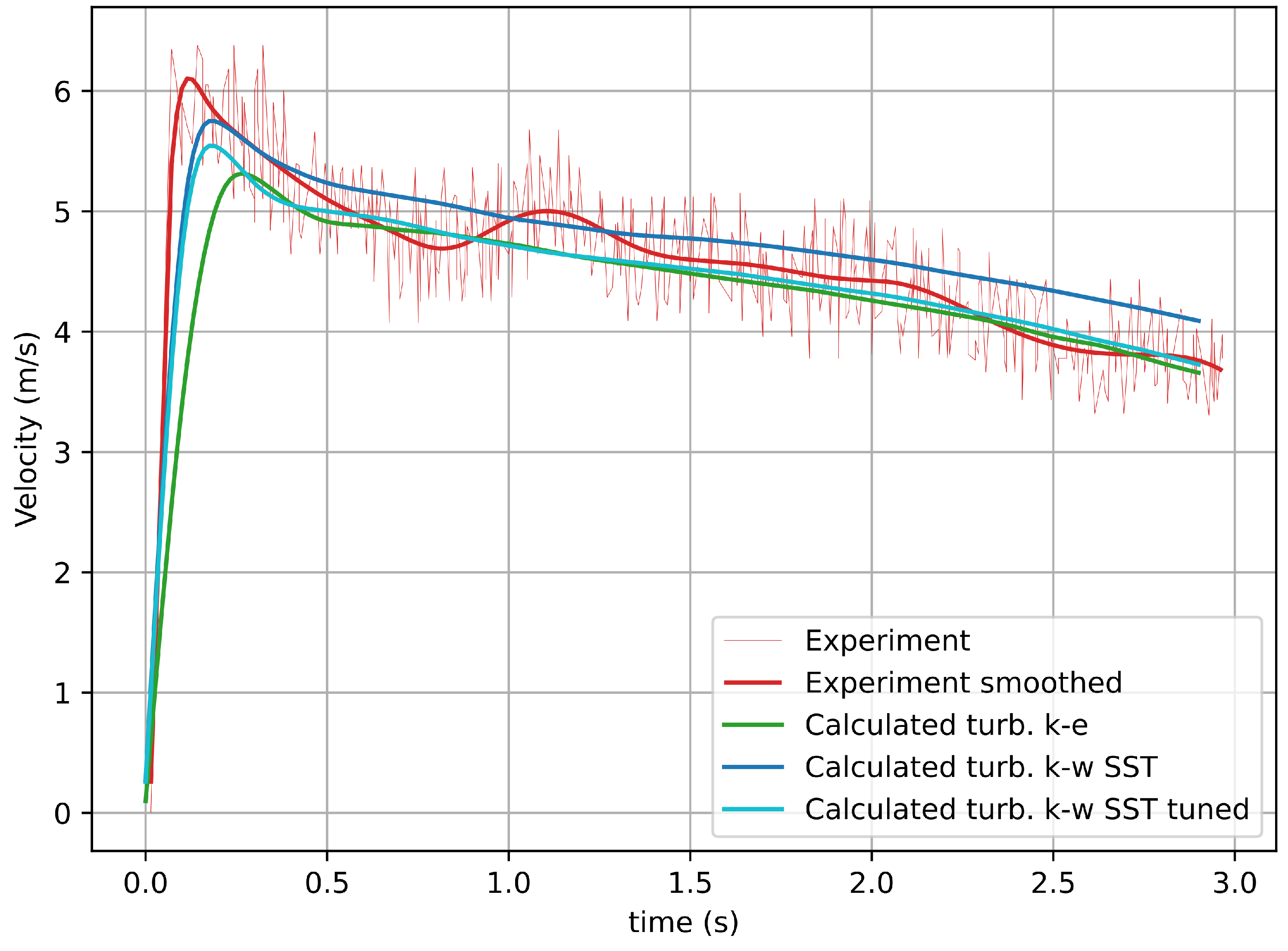
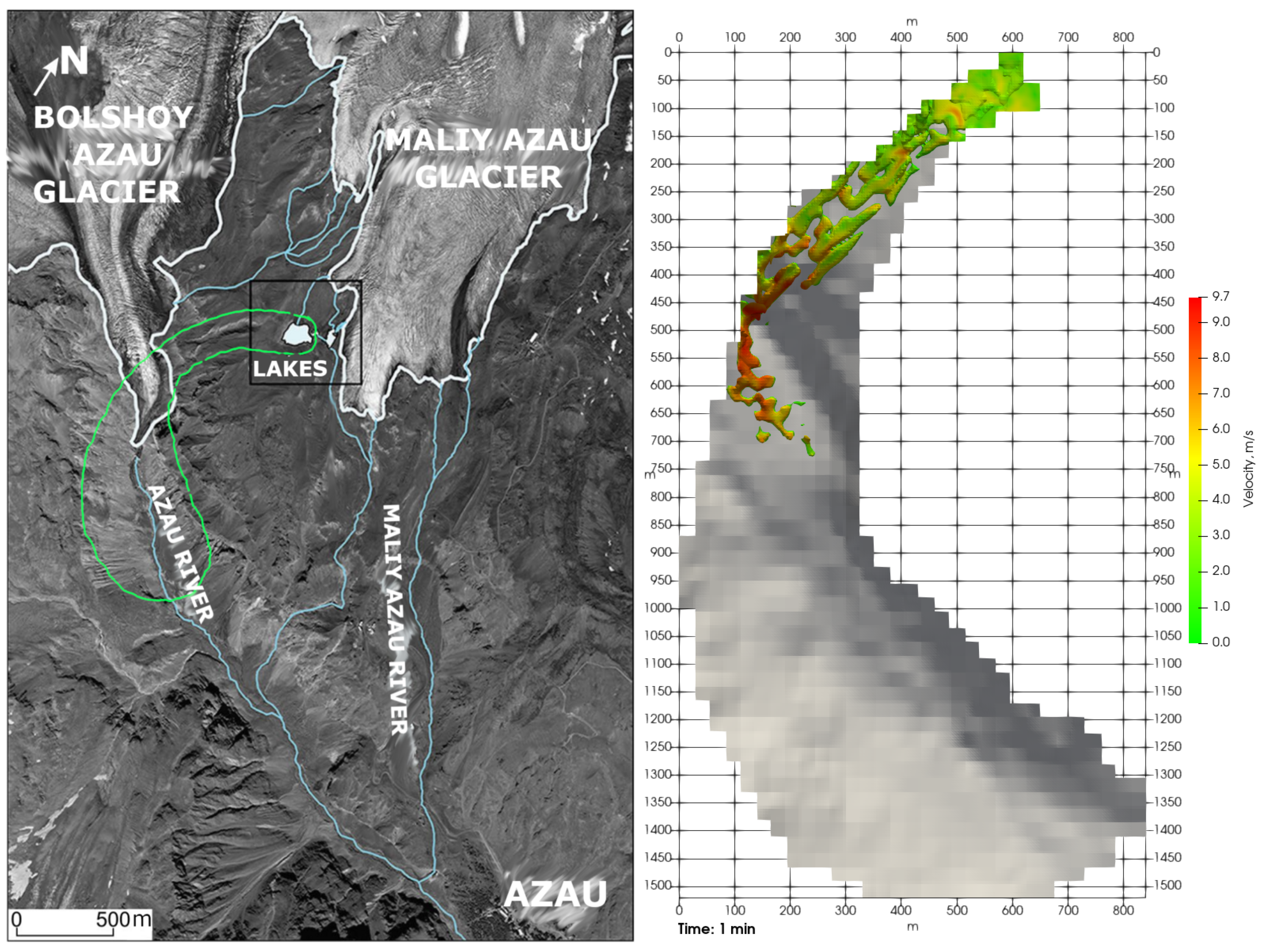
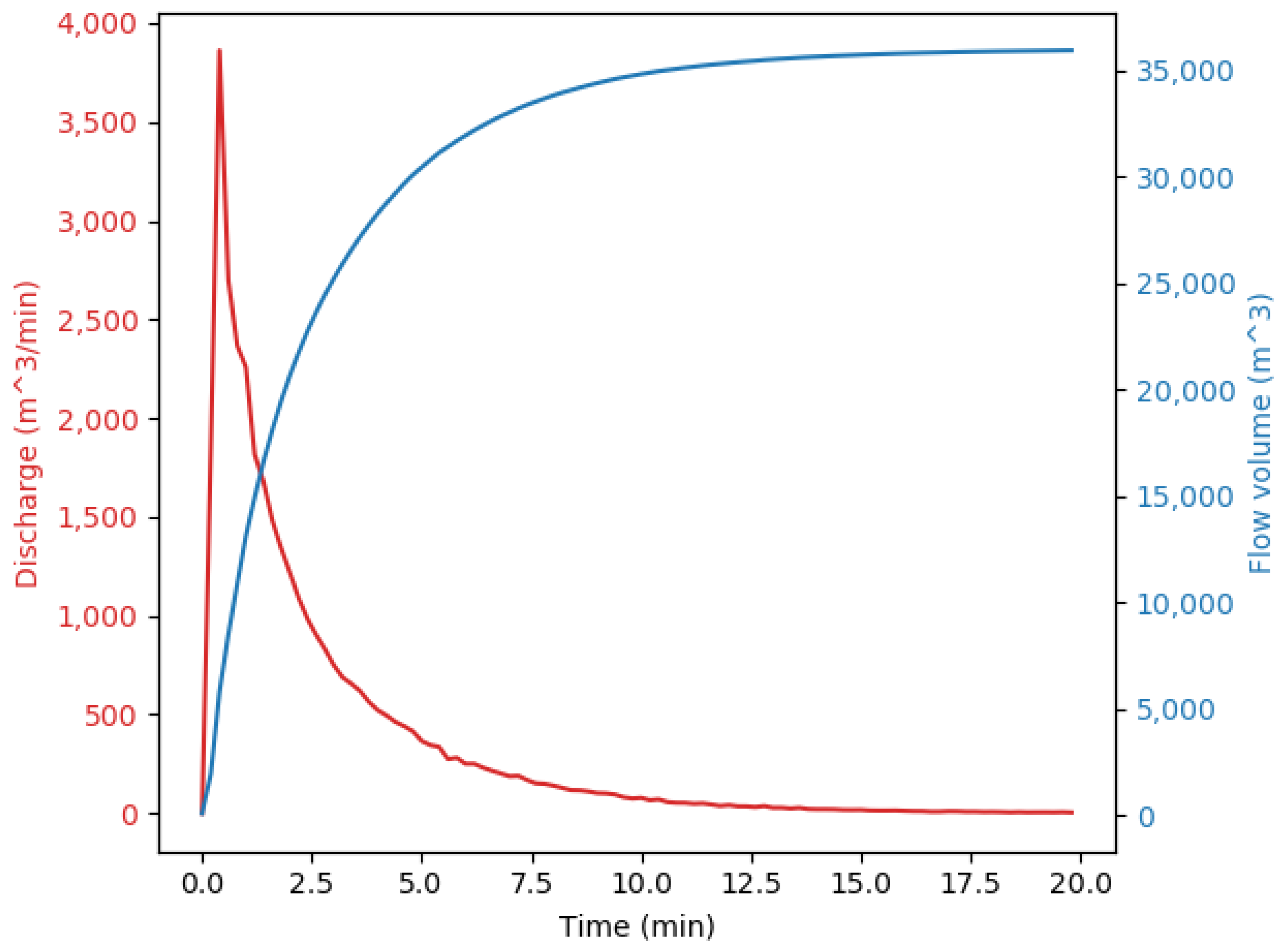
| Parameters | MSU Experiment | UI Experiment | Maliy Azau GLOF |
|---|---|---|---|
| Density, [] | 1000 | 1000 | 1000 |
| Average velocity, [] | 2.5 | 1 | 10 |
| Flow path length, L [m] | 0.5 | 15 | 1500 |
| Average depth, [m] | 0.004 | 0.1 | 0.1 |
| Average slope angle, | 30 | 15 | 25 |
| Viscosity, [] | |||
| Reynolds number, |
| Comparison Parameter | Experiment [38] | Simulations | |
|---|---|---|---|
| -Model | -SSTModel | ||
| Height of initial splash on main dam | 1.3 m | 1.61 m | 1.95 m |
| Overflow time of the flow over the main dam | 1.25 s | 1.3 s | 1.3 s |
| Volume of liquid (of 2.7 m) retained by the dam | 2.684 m | 2.650 m | 2.635 m |
| (Depth-Averaged), m/s | , mm | ||
|---|---|---|---|
| 1.63 | 4.20 | 25 | 8.03 |
| 2.00 | 4.95 | 28 | 9.08 |
| 1.78 | 3.45 | 33 | 9.68 |
| Slope Angle | Initial Value of Loss Function | Minimized Value of Loss Function |
|---|---|---|
| 25 | 0.165 | 0.154 |
| 28 | 0.085 | 0.082 |
| 33 | 0.150 | 0.124 |
| Comparison Parameter | Experiment Data | Calculation Data | ||
|---|---|---|---|---|
| - Turbulence Model | - Turbulence Model | Tuned - Turbulence Model | ||
| Height of initial splash on main dam | 1.3 m | 1.61 m | 1.95 m | 1.5 m |
| Overflow time of the flow over the main dam | 1.25 s | 1.3 s | 1.3 s | 1.26 s |
| Volume of liquid (of 2.7 m) retained by the dam | 2.684 m | 2.650 m | 2.635 m | 2.676 m |
Publisher’s Note: MDPI stays neutral with regard to jurisdictional claims in published maps and institutional affiliations. |
© 2022 by the authors. Licensee MDPI, Basel, Switzerland. This article is an open access article distributed under the terms and conditions of the Creative Commons Attribution (CC BY) license (https://creativecommons.org/licenses/by/4.0/).
Share and Cite
Romanova, D.; Ivanov, O.; Trifonov, V.; Ginzburg, N.; Korovina, D.; Ginzburg, B.; Koltunov, N.; Eglit, M.; Strijhak, S. Calibration of the k-ω SST Turbulence Model for Free Surface Flows on Mountain Slopes Using an Experiment. Fluids 2022, 7, 111. https://doi.org/10.3390/fluids7030111
Romanova D, Ivanov O, Trifonov V, Ginzburg N, Korovina D, Ginzburg B, Koltunov N, Eglit M, Strijhak S. Calibration of the k-ω SST Turbulence Model for Free Surface Flows on Mountain Slopes Using an Experiment. Fluids. 2022; 7(3):111. https://doi.org/10.3390/fluids7030111
Chicago/Turabian StyleRomanova, Daria, Oleg Ivanov, Vladimir Trifonov, Nika Ginzburg, Daria Korovina, Boris Ginzburg, Nikita Koltunov, Margarita Eglit, and Sergey Strijhak. 2022. "Calibration of the k-ω SST Turbulence Model for Free Surface Flows on Mountain Slopes Using an Experiment" Fluids 7, no. 3: 111. https://doi.org/10.3390/fluids7030111
APA StyleRomanova, D., Ivanov, O., Trifonov, V., Ginzburg, N., Korovina, D., Ginzburg, B., Koltunov, N., Eglit, M., & Strijhak, S. (2022). Calibration of the k-ω SST Turbulence Model for Free Surface Flows on Mountain Slopes Using an Experiment. Fluids, 7(3), 111. https://doi.org/10.3390/fluids7030111






